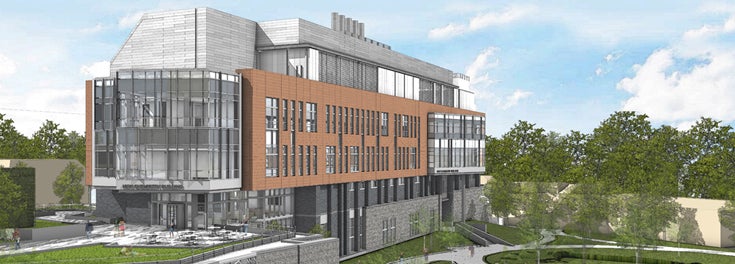
Here’s Chemistry Professor Jason Dwyer’s big idea: Give first responders a hand-held device that tests blood and diagnoses medical conditions in challenging environments, allowing them to provide the injured with immediate, life-saving treatment.
Professor Dwyer won the National Science Foundation’s most prestigious grant for a junior faculty member—an “early career” grant of $400,000 over five years—to develop his idea, which combines chemistry and engineering. And he’s sharing his enthusiasm with the students working with him. The key to this project, he says, is to first develop a chemical sensor that can detect low levels of molecules—indicators of disease—in the blood. Then turn the sensor into an easy-to-use, hand-held device.
Modern facilities energize students and faculty alike. Our talented young faculty were attracted to URI… to be able to train our undergraduate and graduate students in a cutting-edge environment, while tackling significiant scientific and technological problems. ~ Professor William Euler
That’s the kind of chemistry that will flourish in URI’s new Center for Chemical and Forensic Sciences. Currently under construction, the Center is a $68 million, 135,000-square-foot modern chemistry building that will accommodate the more than 6,000 students who take chemistry courses every year.
“Chemistry is the foundation to practically every important area of endeavor, whether it’s the health sciences, biotechnology, energy, the environment, pharmacy, nursing or high technology,” said URI President David M. Dooley.
The Center’s design is in keeping with some of the elements of its newest Kingston campus neighbors, including sustainable design features such as the use of natural light and energy saving infrastructure components. The design also includes a generous amount of space dedicated to collaboration between faculty and students.
The main level of the five-story structure will include eight general chemistry teaching labs with support space, a 24-seat lecture hall, a 105-seat lecture hall, a study rooms and administration offices. Level two will feature five organic chemistry teaching labs and advanced chemistry teaching lab, an instrumentation lab, a 35-seat classroom and offices for faculty and lab managers. Each lab will have workstations compliant with the Americans with Disabilities Act. Levels three and four will each feature 18 faculty research labs with support space.
URI chemistry faculty, internationally recognized in explosives-detection and the battle against terrorism, are also leaders in research involving advanced batteries for energy efficient cars, improving MRI image resolution, and creating clinical methods for earlier disease detection.
The new facility’s state-of-the-art equipment “will allow faculty to compete more effectively for grants and move scientific discoveries into the marketplace more rapidly,” said Winifred Brownell, dean of the College of Arts and Sciences.
“Modern facilities energize students and faculty alike,” said William Euler, professor and chair of the Department of Chemistry. “All of our talented young faculty were attracted to URI, in part, by the possibilities with such a facility—to be able to train our undergraduate and graduate students in a cutting-edge environment, while tackling significant scientific and technological problems. Students and potential students are enthused because they know it will provide them the best experience to compete and succeed in the job market.”
And, like Professor Dwyer and his students, they will be on the cutting edge of innovations and discoveries with the potential to improve and save lives.
